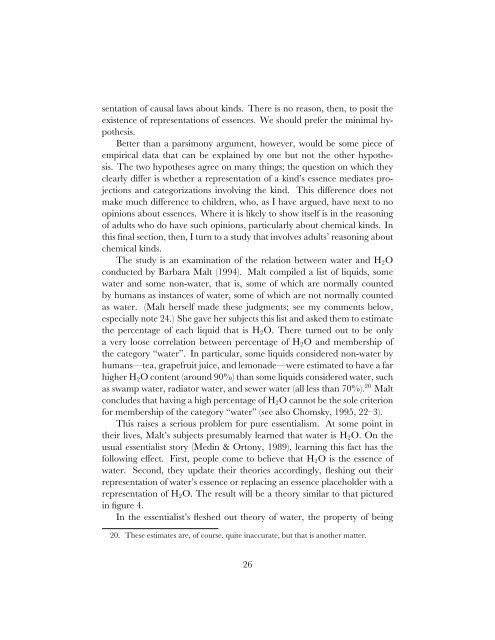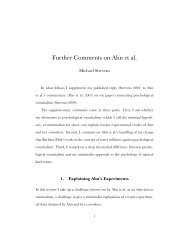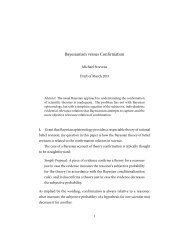The Essentialist Aspect of Naive Theories - Michael Strevens
The Essentialist Aspect of Naive Theories - Michael Strevens
The Essentialist Aspect of Naive Theories - Michael Strevens
You also want an ePaper? Increase the reach of your titles
YUMPU automatically turns print PDFs into web optimized ePapers that Google loves.
sentation <strong>of</strong> causal laws about kinds. <strong>The</strong>re is no reason, then, to posit the<br />
existence <strong>of</strong> representations <strong>of</strong> essences. We should prefer the minimal hypothesis.<br />
Better than a parsimony argument, however, would be some piece <strong>of</strong><br />
empirical data that can be explained by one but not the other hypothesis.<br />
<strong>The</strong> two hypotheses agree on many things; the question on which they<br />
clearly differ is whether a representation <strong>of</strong> a kind’s essence mediates projections<br />
and categorizations involving the kind. This difference does not<br />
make much difference to children, who, as I have argued, have next to no<br />
opinions about essences. Where it is likely to show itself is in the reasoning<br />
<strong>of</strong> adults who do have such opinions, particularly about chemical kinds. In<br />
this final section, then, I turn to a study that involves adults’ reasoning about<br />
chemical kinds.<br />
<strong>The</strong> study is an examination <strong>of</strong> the relation between water and H 2 O<br />
conducted by Barbara Malt (1994). Malt compiled a list <strong>of</strong> liquids, some<br />
water and some non-water, that is, some <strong>of</strong> which are normally counted<br />
by humans as instances <strong>of</strong> water, some <strong>of</strong> which are not normally counted<br />
as water. (Malt herself made these judgments; see my comments below,<br />
especially note 24.) She gave her subjects this list and asked them to estimate<br />
the percentage <strong>of</strong> each liquid that is H 2 O. <strong>The</strong>re turned out to be only<br />
a very loose correlation between percentage <strong>of</strong> H 2 O and membership <strong>of</strong><br />
the category “water”. In particular, some liquids considered non-water by<br />
humans—tea, grapefruit juice, and lemonade—were estimated to have a far<br />
higher H 2 O content (around 90%) than some liquids considered water, such<br />
as swamp water, radiator water, and sewer water (all less than 70%). 20 Malt<br />
concludes that having a high percentage <strong>of</strong> H 2 O cannot be the sole criterion<br />
for membership <strong>of</strong> the category “water” (see also Chomsky, 1995, 22–3).<br />
This raises a serious problem for pure essentialism. At some point in<br />
their lives, Malt’s subjects presumably learned that water is H 2 O. On the<br />
usual essentialist story (Medin & Ortony, 1989), learning this fact has the<br />
following effect. First, people come to believe that H 2 O is the essence <strong>of</strong><br />
water. Second, they update their theories accordingly, fleshing out their<br />
representation <strong>of</strong> water’s essence or replacing an essence placeholder with a<br />
representation <strong>of</strong> H 2 O. <strong>The</strong> result will be a theory similar to that pictured<br />
in figure 4.<br />
In the essentialist’s fleshed out theory <strong>of</strong> water, the property <strong>of</strong> being<br />
20. <strong>The</strong>se estimates are, <strong>of</strong> course, quite inaccurate, but that is another matter.<br />
26






